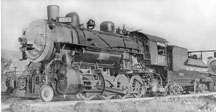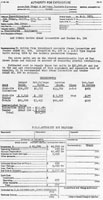The only survivor of the many steam locomotives owned by San Diego County railroads, San Diego & Arizona #104 is one of the SDRM's most prized artifacts. It was built by the Baldwin Locomotive Works in Philadelphia, PA as #23899 and delivered May 17, 1904. This Class C-8 (Class C-57-22/30-192-S for its driver and cylinder size, weight on drivers and Superheater) is a 2-8-2 Consolidation-type oil-burning road engine.

It originally weighed 206,800 lbs (103.4 tons), with 183,000 lbs on its 57" drivers, boiler pressure of 200 lbs, and tractive effort of 43,300 lbs. A Superheater added December 21, 1918, at Sacramento increased these to 216,700 lbs (108.35 tons), with 191,900 lbs on drivers, 210 lbs boiler pressure, and 45,470 lbs tractive effort. It has 22" x 30" cylinders, Stephenson Link valve gear, and is 38' 5 3/16" long, 10' 0" wide, and 15' 8 3/4" high.
Built for the SP for $17,969 and numbered SP #2720, the locomotive worked on SP lines until purchased by the SD&A March 25, 1921, for $37,000 (paid in January 1922). Renumbered SDA #104, it was used in freight service and also on passenger runs, because it was the "...smoothest riding" SD&A locomotive, according to SD&A/SD&AE engineer and later PSRMA member Christian Brown.
Besides serving on the SD&A's San Diego-Campo-El Centro mainline, it pulled through trains via the SP to Niland, CA (connecting with the LA-New Orleans Sunset, mainly in 1922-26), and via Calexico, Mexicali, Algodones, and Cantu on SP's Ferrocarril Inter-California subsidiary in Mexico (abandoned in 1959) to Yuma, AZ (connecting with the Golden State, Californian, Imperial, and other LA-Chicago and LA-New Orleans trains). Its tractive effort was appreciated on the SD&A, which started at sea level, climbed to 3,660 feet, and descended to -49 feet.
In 1923, SDA #104 was used in making a promotional film, Carriso Gorge, The Magnificent, and in 1926 was in the Goldwyn movie Red Lights, with Marie Prevost, Raymond Griffith, Johnnie Walker, and Jean Hersholt, filmed near Hipass. Elmer Hall was engineer, and Howard de France the fireman. Hall stated that some of the breathtaking scenes in Red Lights were too realistic for comfort!
Another serio-comic incident took place when #104 was pulling westbound train #3, the Golden State connection, near Matanuco, BC, with Christian Brown at the throttle and usually "very deliberate" Don Diebert firing. The left rear side rod suddenly broke close to the crank pin of the main, or third, driving wheel. The loose end was hurled around, knocking off the bottom of the air pump and striking the cab right under the fireman's seat. Diebert leaped across the deck and landed on top of Brown, ...the fastest I ever saw Don move!", said Brown.
 SP acquired the SD&A in 1932, and in 1933 added "Eastern" to its name. The SDA #104 was relettered SDAE #104. Often used on other SP lines, it was in Pasadena in October 1937, and Los Angeles in December 1937, February 1940, and January 1941. In July 1939, it was taken via Santa Barbara to the SP's Bayshore yards south of San Francisco at Brisbane for major repairs. Its Sunbeam headlight atop the front end was replaced between July 1939 and February 1940 by a Pyle National headlight with visor, placed slightly below center on the front of the smokebox face, which was painted silver about that time.
SP acquired the SD&A in 1932, and in 1933 added "Eastern" to its name. The SDA #104 was relettered SDAE #104. Often used on other SP lines, it was in Pasadena in October 1937, and Los Angeles in December 1937, February 1940, and January 1941. In July 1939, it was taken via Santa Barbara to the SP's Bayshore yards south of San Francisco at Brisbane for major repairs. Its Sunbeam headlight atop the front end was replaced between July 1939 and February 1940 by a Pyle National headlight with visor, placed slightly below center on the front of the smokebox face, which was painted silver about that time.
SDAE #104 was requisitioned by the SP May 21, 1941, on long-term lease "...for war duty" (although the U.S.A. was not yet in World War II), and given back its original SP #2720 number June 2, 1941. It served on several SP lines in World War II including the SD&AE, the Imperial County lines, and the Coast division. It was at San Luis Obispo on September 16, 1946, as a helper on the colorful postwar Los Angeles-San Francisco Noon Daylight steam-powered streamliner, and was also there in March 1948.
 SP #2720 was returned to the SD&AE in September 1948, renumbered SDAE #104 again, and used in regular freight and enroute switching service, and in heavy switching in San Diego. Richard Dick, now a PSRMA member, was one of its firemen. When diesels came to the SD&AE in 1950, the Consolidation was leased to the SP again, retaining its SDAE #104 number. Sent to the bay area, it worked out of SP's Bayshore yards until retired October 18, 1954.
SP #2720 was returned to the SD&AE in September 1948, renumbered SDAE #104 again, and used in regular freight and enroute switching service, and in heavy switching in San Diego. Richard Dick, now a PSRMA member, was one of its firemen. When diesels came to the SD&AE in 1950, the Consolidation was leased to the SP again, retaining its SDAE #104 number. Sent to the bay area, it worked out of SP's Bayshore yards until retired October 18, 1954.

The SP knew it was the last surviving steam locomotive that had been owned by a San Diego-based railroad, and offered to donate it and former SD&A/SD&AE business car #050 Carriso Gorge to the City of San Diego. When the offer wasn't acted on, the county's first rail buff group, the Railway Historical Society of San Diego, led by Lyle Judd, Eric Sanders, Jack Stodelle, and Doug Duncan (later PSRMA founders) arranged to have the locally-important artifacts donated to the Southern California / San Diego County Fair at Del Mar, and raised $1,600 to move them to the fairgrounds. Freshly painted, with new classification numbers on SDAE #104's cab, they arrived in San Diego (stopping at Campo enroute) September 2, 1955, and were moved into the fairgrounds September 27th. The railroading exhibit was dedicated June 24,1956.
Staffed by RHS members each year at fair time, it was seen by hundreds of thousands of visitors for 27 years. The RHS, which opted not to sponsor an operating railway museum, experienced a decline in membership following the founding of the PSRMA in 1961, and became defunct in the 1980's. The 22nd District Agricultural Association (the fair operator) donated it to the PSRMA for removal and preservation on February 22, 1982. A plaque is to be affixed to the equipment, noting its donation by the Association, the RHS and the SP.
The locomotive, tender, and car were taken by road transporters to nearby Solana Beach and placed on a Santa Fe siding February 15, 1983, after the PSRMA raised trucking costs of $10,000. They were moved free to San Diego by the Santa Fe and to San Ysidro by the Kyle-operated SD&AE, and were taken to Campo (where they're now on "home rails" again!) in August, 1983, on the PSRMA's first Great Freight.
Redesignated SDA #104, the locomotive was inspected, and some repairs made. Its deteriorated condition and the need to utilize limited museum resources on more easily restorable locomotives has delayed SDA #104's operational restoration, though that's still a long-term museum goal. Since 1992, SDA #104 has received additional repairs, and is being cosmetically restored for display at Campo Depot by museum workers led by Dick Pennick. It's the intent of the museum to restore to operating condition when personnel and funds permit.
Imagine SDA #104 double-heading a museum train with SP #2353! It will happen, we're already halfway there!
Special Thanks are expressed to PSRMA Member P. Allen Copeland, who provided much of the information in this article through books, articles, and conversations. Other sources are the SDRM Research Library Collections: past REPORT and DISPATCHER issues edited by Eric Sanders with articles by Richard Dodge; personal inspections; photos from Al Rose, Stan Kistler, Gerald Best, John Maxwell. M.D. McCarter, Jack Stodelle, Harold Vollrath, Bob McNeel, and Larry Rose; and the following books; Southern Pacific Company: Steam Locomotives Compendium by Timothy Diebert & Joseph Strapac (Shade Tree Books, 1987) and San Diego & Arizona, the Impossible Railroad by Robert Hanft (Trans-Anglo Books, 1984).
Thank you all!
 Back to the SD&A Steam Locomotive Roster
Back to the SD&A Steam Locomotive Roster
